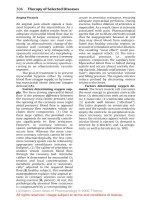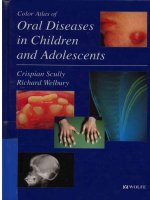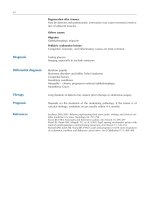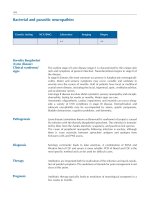Ebook Color atlas of oral diseases: Part 2
Bạn đang xem bản rút gọn của tài liệu. Xem và tải ngay bản đầy đủ của tài liệu tại đây (14.72 MB, 185 trang )
1 88
21. Autoimmune Diseases
Discoid Lupus Erythematosus
Lupus erythematosus is a chronic inflammatory
autoimmune disease with a variable spectrum of
clinical forms in which mucocutaneous lesions
may occur with or without systemic manifestations.
Discoid lupus erythematosus (DLE) is the
more common form of the disease. It tends to be
confined to the skin and has a benign course in the
vast majority of patients. The skin lesions are
characterized by violaceous papules and patches,
scaling, and prominent follicular hyperkeratosis.
These lesions are sharply demarcated from the
surrounding healthy skin and progress to scarring
with atrophy and telangiectasia. Discoid lupus
lesions are very often located above the neck
region (face, scalp, and ears) and usually form a
characteristic "butterfly" pattern on the face (Fig.
302). If the disease involves areas above and
below the neck, it is characterized as generalized
DLE. The cutaneous lesions persist for months to
years.
The oral mucosa is involved in 15 to 25% of the
cases, usually in association with skin lesions.
However, on rare occasions, oral lesions may
occur alone.
The typical oral lesions are characterized by a
well-defined central atrophic red area surrounded
by a sharp elevated border of irradiating whitish
striae (Fig. 303). Telangiectases and small white
dots may be present on the erythematous areas.
Ulcers, erosions, or white plaques may also be
present and progress to atrophic scarring (Fig.
304).
The buccal mucosa is the most frequently affected site, followed by the lower lip, palate,
gingiva, and tongue. Generally, the clinical features of oral lesions are not pathognomonic.
The differential diagnosis should include leukoplakia, erythroplakia, lichen planus, geographic
stomatitis, syphilis, and cicatricial pemphigoid.
Laboratory tests. Serum antinuclear antibodies
are infrequently present at low titers and antidouble-stranded DNA antibodies are rarely present. Subepidermal immunoglobulins are detected
in 75% of biopsy specimens of involved skin
or mucosae, using fluorescent techniques. Histopathologic examination of oral lesions is also
helpful.
Treatment. The oral lesions of DLE are treated
with local steroids if the lesions are small or with
systemic steroids or antimalarials in case the disease is more extensive.
21. Autoimmune Diseases
Fig. 302. Discoid lupus
erythematosus, characteristic
butterfly-like eruption on the face.
Fig. 303. Discoid lupus
erythematosus, typical lesion on the
buccal mucosa.
Fig. 304. Discoid lupus
erythematosus, ulcer on the lower lip.
189
190
21. Autoimmune Diseases
Fig. 305. Systemic lupus
erythematosus, multiple erosions
surrounded by a whitish or reddish
zone.
Systemic Lupus Erythematosus
Scleroderma
Systemic lupus erythematosus (SLE) is a serious
systemic disease involving the skin, mucosae, cardiovascular and gastrointestinal systems, lungs,
kidneys, joints, and nervous system. It is accompanied by fever, fatigue, weight loss, lymphadenopathy, and debilitation. The oral mucosa is
involved in 30 to 45% of the cases. Clinically,
there are extensive painful erosions, or ulcers
surrounded by a reddish or whitish zone (Fig.
305). Frequent findings include petechiae, edema,
hemorrhages, and xerostomia. White hyperkeratotic lesions are rarely observed.
The palate, lips, and buccal mucosa are the
most frequently involved sites.
The oral manifestations of SLE are not pathognomonic.
The differential diagnosis includes cicatricial pemphigoid, erosive lichen planus, pemphigus, bullous pemphigoid, erythema multiforme, and dermatomyositis.
Laboratory tests. Histopathologic and immunofluorescent studies of biopsy specimens are essential to make the diagnosis. The presence of antidouble-stranded DNA antibodies in the serum
and hematologic abnormalities are also helpful in
establishing the diagnosis.
Treatment. Depending on the overall clinical severity of the disease, therapy consists of systemic
steroids, nonsteroidal anti-inflammatory drugs,
antimalarials, immunosuppressants, and plasmapheresis if immune complexes are present.
Scleroderma is a chronic connective tissue disorder often classified as an autoimmune disease,
although the precise cause is unknown. It primarily affects women between 30 and 40 years of age.
Two forms of the disease are distinguished:
localized scleroderma (morphea) and progressive
systemic sclerosis. The localized form has a favorable prognosis and involves the skin alone,
whereas the systemic form of the disease is characterized by multisystem involvement, including the
skin and oral mucosa. Initially, the skin is edematous, but, as the disease progresses, it becomes
thin, hard, and inelastic, with a pale appearance.
Skin necrosis and ulcer occur in severe cases (Fig.
306). Involvement of the facial skin results in a
characteristic facies with a small, sharp nose,
expressionless stare, and narrow oral aperture
(Fig. 307). Raynaud's phenomenon is usually
present. The oral mucosa is pale and thin with a
smooth dorsal surface of the tongue due to papillary atrophy (Fig. 308). Frequent findings include
smoothing out of the palatal folds, and short and
hard tongue frenulum, which results in dysarthria.
As the disease progresses, there are limitations of
mouth opening and induration of the tongue and
gingiva. A clinical variant of scleroderma is the
CREST syndrome, which is characterized by a
combination of calcinosis cutis, Raynaud's
phenomenon, esophageal dysfunction, sclerodactyly, and telangiectasia. Telangiectasia can occur
on the lips and oral mucosa (Fig. 309).
21. Autoimmune Diseases
Fig. 306. Progressive systemic
sclerosis, ulcer and gangrene of the
skin and toe.
Fig. 307. Progressive systemic
sclerosis, characteristic facies.
Fig. 308. Progressive systemic
sclerosis, pale and atrophic
epithelium of the dorsum of the
tongue.
191
19 2
21. Autoimmune Diseases
Fig. 309. CREST syndrome, lip
telangiectasia.
The differential diagnosis of the oral lesions
includes oral submucous fibrosis, cicatricial pemphigoid, epidermolysis bullosa, and lipoid proteinosis.
Laboratory tests. Histopathologic examination of
biopsy specimens is indispensable for diagnosis.
Radiographs show characteristic widening of the
periodontal space in about 20% of the cases of
systemic sclerosis. Various serum antibodies are
present. Anticentromere antibodies have been
reported to characterize the CREST syndrome.
Treatment. The treatment of scleroderma remains
unsatisfactory. Topical and systemic steroids, antimalarials, potassium p-aminobenzoate (Potaba),
D-penicillamine, azathioprine and other immunosuppressives, nifedipine, and other agents
have been tried.
Dermatomyositis
Dermatomyositis is an uncommon inflammatory
disease that is characterized by polymyositis and
dermatitis. The cause is unknown, although an
autoimmune mechanism seems probable. A viral
infection of the skeletal muscle is another theory.
A classification of dermatomyositis into five
groups has been suggested. The disease most frequently affects women, more than 40 years of age.
It may be associated with cancers in 10 to 20% of
the cases. Progressive symmetrical muscle weakness is usually the first and most important clinical
manifestation in the majority of patients with der-
matomyositis. Myalgia and malaise accompanied
by fever are prominent early features.
In about 30% of the cases a purplish-red
periorbital discoloration and a telangiectatic
erythema at the nail margins are the initial manifestations. During its course, the disease is manifested by an erythematous, scaly papulomacular
rash, skin discoloration, hyperpigmentation, and
atrophy (Fig. 310). The oral cavity is uncommonly
involved. The most frequent lesions are redness,
painful edema, or ulcers on the tongue, the soft
palate, the buccal mucosa, and uvula (Fig. 311).
The differential diagnosis includes SLE, angioneurotic edema, and stomatitis medicamentosa.
Laboratory tests helpful in the diagnosis are serum
enzyme determination (creatine phosphokinase,
aspartine transaminase, alanine transaminase),
serum creatinine, electromyography and histopathologic examination of biopsy specimens.
Treatment. Steroids are the cornerstone. Cytotoxic drugs should be used when the disease is
severe. Plasmapheresis has been used effectively.
21. Autoimmune Diseases
Fig. 310. Dermatomyositis, edema
and maculopapular rash on the skin of
the face.
Fig. 311. Dermatomyositis,
erythema, edema, and ulcer on the
buccal mucosa.
1 93
19 4
21. Autoimmune Diseases
Mixed Connective Tissue Disease
Mixed connective tissue disease (MCTD) is a multisystemic disorder characterized by a combination of clinical features similar to those observed
in systemic lupus erythematosus, scleroderma,
polymyositis, and rheumatoid arthritis, which is
characteristically associated with high titers of
antibody to a nuclear ribonucleoprotein antigen.
The cause and pathogenesis of mixed connective
tissue disease is unknown. Females are more commonly affected, with a mean of 35 years.
Clinically, the disease is characterized by Raynaud's phenomenon, polyarthralgia or arthritis,
sclerodactyly or diffuse swelling of the hands,
inflammatory myopathy, pulmonary and esophageal involvement, skin and mucosal lesions, and
lymphadenopathy. Less common clinical manifestations are musculoskeletal abnormalities, cardiac
and renal disorders, neurologic abnormalities,
intestinal involvement, and Sjogren's syndrome.
Orofacial manifestations of mixed connective tissue disease include Sjogren's syndrome, trigeminal neuropathy, and peripheral facial paralysis.
Rarely telangiectasia and erosions of the oral
mucosa may be seen (Fig. 312).
The differential diagnosis includes Sjogren's syndome and oral manifestations of other connective
tissue diseases.
Laboratory test. Almost all patients have characteristically high titers of antibody to nuclear
ribonucleoprotein (RNP) antigen.
Treatment. Systemic corticosteroid, nonsteroidal
anti-inflammatory drugs, chloroquine, and, in
severe cases, cytotoxic agents have been used.
Sjogren's Syndrome
Sjogren's syndrome is a chronic autoimmune
exocrinopathy that predominantly involves lacrimal, salivary, and other exocrine glands, resulting
in a decreased secretion. Most frequently, it
affects women in the fourth and fifth decades and
is characterized by xerostomia and keratoconjunctivitis sicca. Recent clinical, serologic, and genetic
criteria have been used to distinguish two forms of
the disease: primary and secondary. Sjogren's syndrome is primary when it is not accompanied by a
collagen disease and secondary if it coexists with
collagen diseases, such as rheumatoid arthritis,
SLE, polymyositis, or with primary biliary cirrhosis, thyroiditis, vasculitides, or cryoglobulinemia. The cardinal clinical manifestations
include a recurrent enlargement of the parotid,
submandibular (Fig. 313), and lacrimal glands,
lymphadenopathy, purpura, Raynaud's phenomenon, myositis, renal and pulmonary manifestations that occur in varying frequencies, depending
on whether the disease is primary or secondary.
Xerostomia is the classic finding in the oral cavity.
The oral mucosa is reddish, dry, smooth, shiny,
and the tongue is smooth with furrowing and
appears lobulated (Fig. 314). Frequent findings
include dysphagia, candidosis, cheilitis, and dental
caries. Oral involvement is usually more severe in
primary Sjogren's syndrome. The prognosis
remains uncertain, and there is an increased risk
of lymphomas in patients with enlarged parotids.
The differential diagnosis of oral lesions should
include xerostomia due to other causes (such as
drugs, neurologic disorders), iron deficiency
anemia, systemic sclerosis, Mikulicz's syndrome,
Heerfordt's syndrome, and sialosis.
Laboratory tests useful to establish the diagnosis
include Schirmer's lacrimation test, determination
of salivary flow rate, histopathologic examination
of a biopsy from the lower lip, sialography, and
scintigraphy. Many Sjogren's patients have a positive ANA test. Specific antibodies such as antiSS-A(Ro) and anti-SS-B(La) are found in patients with Sjogren's syndrome.
Treatment is directed toward maintenance of oral
hygiene. Artificial saliva and sialagogues may
alleviate dryness of the mouth. Artificial tears are
indicated. Systemic steroids and other immunosuppressants may be used.
21. Autoimmune Diseases
Fig. 312. Mixed connective tissue
disease, multiple palatal erosions.
Fig. 313. Sjogren's syndrome,
bilateral enlargement of the
submandibular glands.
Fig. 314. Sjogren's syndrome, dry
and lobulated tongue.
195
19 6
21. Autoimmune Diseases
Benign Lymphoepithelial Lesion
Lupoid Hepatitis
The term "benign lymphoepithelial lesion" is used
to define a localized lymphocytic infiltration of the
salivary and lacrimal glands. Some investigators
classify this lesion as a monosymptomatic form of
Sjogren's syndrome. It affects most frequently
middle-aged women. Clinically, there are small
raised painless nodules of minor salivary glands,
usually on the posterior part of palate (Fig. 315).
When the parotids are involved, there is a
painless symmetrical enlargement that may cause
mild xerostomia and an uncomfortable feeling.
The duration of the disease may extend over
months or years, with fluctuations in the size of
the lesion.
Lupoid hepatitis is a form of chronic active
hepatitis of autoimmune origin, which most frequently affects young women. In addition to liver
involvement there are frequently renal, arthritic,
lung, and bowel manifestations, hemolytic
anemia, and amenorrhea.
Rarely, the oral mucosa is involved. Figure 317
shows a patient with erythematous and edematous
gingiva that are tender on palpation. The only
difference from desquamative gingivitis is that
friction did not cause detachment of the
epithelium.
The differential diagnosis includes necrotizing
sialometaplasia and minor salivary gland tumors.
Laboratory tests helpful for diagnosis include
serologic and immunologic examination and liver
biopsy.
Laboratory test. Histopathologic examination is
definitive in establishing the diagnosis.
Treatment. Steroids and nonsteroid anti-inflammatory agents are the usual therapeutic measures.
Primary Biliary Cirrhosis
Primary biliary cirrhosis is a serious autoimmune
disease characterized by intrahepatic cholestasis
leading to hepatic cirrhosis. Most frequently, it
affects women in the fourth to sixth decades. The
cardinal clinical manifestations are jaundice,
pruritus, and cutaneous xanthomas. Late manifestations are portal hypertension and the sequelae
of cirrhosis (ascites, esophageal varices, encephalopathy, osteomalacia, etc.). During the late
stages of the disease, the oral mucosa is red, thin,
and atrophic with telangiectasias (Fig. 316).
The differential diagnosis includes mainly lupus
erythematosus, scleroderma and CREST syndrome.
Laboratory tests helpful for diagnosis include
serologic and immunologic tests and liver biopsy.
Treatment is managed by a team of specialists.
The differential diagnosis includes desquamative
gingivitis and plasma cell gingivitis.
Treatment is managed by a team of specialists.
21. Autoimmune Diseases
Fig. 315. Benign lymphoepithelial
lesion, nodule on the palate.
Fig. 316. Primary biliary cirrhosis,
telangiectasias of the lower lip.
Fig. 317. Lupoid hepatitis, diffuse
edema and erythema of the upper
gingiva.
197
1 98
22. Skin Diseases
Erythema Multiforme
Erythema multiforme is an acute or subacute selfli miting disease that mainly involves the skin and
mucous membranes. Although the exact cause is
obscure, a plethora of different agents, such as
drugs, infections, radiation, endocrine factors,
neoplasia, collagen diseases, and physical factors
have been implicated. Immunologic disturbances
have also been described. Erythema multiforme
occurs chiefly in young adults between 20 and 40
years of age. Men are more frequently affected
than women. The disease affects mainly the skin
and has a sudden onset with the occurrence of red
macules and papules in a symmetrical pattern on
the palms and soles and less commonly on the
face, neck, and trunk. These lesions are small and
may increase in size centrifugally, reaching a
diameter of 1 to 2 cm in 24 to 48 hours. The
periphery remains erythematous, but the center
becomes cyanotic or even purpuric, forming the
characteristic target or iris lesion (Fig. 318).
Rarely, bullae develop on preexisting maculopapular lesions, giving rise to the bullous form of
the disease. In the oral cavity small vesicles
develop that rupture and leave an eroded surface
covered by a necrotic pseudomembrane. Lesions
may be seen anywhere in the mouth, but the lips
and the anterior part of the mouth are most commonly involved (Fig. 319). Conjunctivitis,
balanitis, and vaginitis may also be present. Fever,
malaise, and arthralgias are also common. The
diagnosis is primarily based on clinical criteria.
The differential diagnosis includes stomatitis
medicamentosa, Stevens-Johnson syndrome, toxic
epidermal necrolysis, pemphigus, bullous and erosive lichen planus, cicatricial pemphigoid, bullous
pemphigoid, primary herpetic gingivostomatitis,
and recurrent aphthous ulcers.
Laboratory findings. A histopathologic examination of the lesions is suggestive of the disease.
Treatment. Systemic steroids.
Fig. 318. Erythema multiforme,
typical target (iris)-like lesions of the
skin.
22. Skin Diseases
1 99
Fig. 319. Erythema multiforme,
multiple erosions on the lips and
tongue.
Stevens-Johnson Syndrome
Stevens-Johnson syndrome is recognized as a
severe form of erythema multiforme that predominantly involves the mucous membranes. Prodromal systemic illness (fever, cough, weakness,
malaise, sore throat, arthralgias, myalgias,
diarrhea, etc.) usually precedes the appearance of
bullae and erosions on the mucous membranes.
The oral mucosa is invariably involved, with
extensive formation of bullae followed by
Fig. 320. Stevens-Johnson
syndrome, widespread erosions
covered by hemorrhagic crusting on
the lips and tongue.
extremely painful erosions covered by grayishwhite or hemorrhagic pseudomembranes (Fig.
320). The lips usually show characteristic bloody
crusting. Erosions may extend to the pharynx,
larynx, esophagus, and respiratory system. The
ocular lesions consist of conjunctivitis, but corneal
ulceration, anterior uveitis, or panophthalmitis
are not rare and sometimes may lead to symblepharon, corneal opacity or even blindness. The
genital lesions (Fig. 321) consist of balanitis or
vulvovaginitis, which in some cases result in
200
22. Skin Diseases
Fig. 321. Stevens-Johnson
syndrome, genital lesions.
phimosis or cicatrization of the vagina. The skin
lesions are variable in extent. They may be either
the typical maculopapular eruption of erythema
multiforme, but more commonly are bullous or
ulcerative (Fig. 322).
Pneumonia and renal involvement have been
reported in severe cases. The mortality rate of
untreated patients ranges from 5 to 15%. Diagnosis is based mainly on clinical criteria.
The differential diagnosis of the oral lesions
includes erythema multiforme, Behcet's syndrome, toxic epidermal necrolysis, pemphigus vulgaris, bullous pemphigoid, and cicatricial pemphigoid.
Laboratory findings. Histopathologic examination
is supportive of the diagnosis.
Treatment. Large doses of systemic steroids and
antibiotics if considered necessary.
Toxic Epidermal Necrolysis
Toxic epidermal necrolysis, or Lyell's disease, is a
severe skin disease with high mortality and is
characterized by extensive eruption and detachment of the necrotic epidermis.
A great variety of etiologic factors have been
incriminated, but mainly drugs, such as antibiotics, sulfonamides, sulfones, nonopiate analgesics,
nonsteroidal anti-inflammatory agents, and antiepileptic drugs, are thought to be responsible for
the disease. Viral, bacterial, and fungal infection,
malignant diseases, and radiation have also been
considered as possible causative factors. The
pathogenesis of the disease still remains unclear,
and an underlying immune mechanism seems
most probable. Clinically, the disease usually
appears with slight malaise, low-grade fever, arthralgias, skin tenderness, burning sensation of
the conjunctivae, and erythema, which begins on
the face and extremities and rapidly extends to the
whole body surface with the exception of the hairy
parts. Within 24 hours, blisters filled with clear
fluid appear, and the erythematous skin is lifted
up so that the whole body surface appears scalded
(Fig. 323). Nikolsky's sign becomes positive early
in the course of the disease. In the oral mucosa
there is severe inflammation, vesiculation, and
painful widespread erosions, primarily on the lips,
buccal mucosa, tongue, and soft palate (Fig. 324).
Similar lesions may be seen on the eyelids, conjunctivae, genitals, and other mucous membranes.
The prognosis is poor. Diagnosis is based on the
clinical features.
The differential diagnosis includes erythema multiforme, Stevens-Johnson syndrome, bullous
pemphigoid, pemphigus, and generalized bullous
fixed-drug eruption.
Treatment. Systemic steroids, antibiotics, fluids
and electrolytes.
22. Skin Diseases
Fig. 322. Stevens-Johnson
syndrome, widespread severe lesions
on the lips, skin, and eyes.
Fig. 323. Toxic epidermal necrolysis,
characteristic detachment of
epidermis, resembling scalding.
Fig. 324. Toxic epidermal necrolysis,
severe erosions covered by
hemorrhagic crusting on the lips.
201
20 2
22. Skin Diseases
Fig. 325. Pemphigus vulgaris,
erosions on the dorsum of the tongue.
Pemphigus
Pemphigus is a chronic autoimmune bullous disease that affects the skin and mucous membranes
and has a reasonable prognosis. The disease shows
a high incidence in Mediterranean races (Jews,
Greeks, Italians) without, however, usually
exhibiting any familial distribution. Our own data
on 157 patients with pemphigus vulgaris, according to which women were more frequently
affected than men (1.6: 1), with ages ranging from
18 to 92 years and a mean age at onset of 54.4
years, are consistent with other reports.
On the basis of clinical, histopathologic, and
immunologic criteria, four varieties of pemphigus
can be recognized: pemphigus vulgaris, pemphigus vegetans, pemphigus foliaceus, and pemphigus erythematosus, or Senear-Usher syndrome.
Pemphigus Vulgaris
Pemphigus vulgaris is the most common form of
the disease and represents 90 to 95% of the cases.
It has been reported that in more than 68% of the
cases the disease presents initially in the oral
cavity, where it may persist for several weeks,
months, or even years before extending to other
sites. Clinically, bullae that rapidly rupture leaving painful erosions are seen (Fig. 325). They
show little evidence of healing, extend peripherally, and the pain may be so severe that dysphagia
can be a serious problem. A characteristic feature
of the oral lesions of pemphigus is the presence of
small linear discontinuities of the oral epithelium
surrounding an active erosion, resulting in epithelial disintegration. Any site in the oral cavity may
be involved, but the soft palate, buccal mucosa,
and lower lip predominate. Lesions on other
mucosal surfaces (conjunctivae, larynx, nose,
pharynx, genitals, anus) may eventually develop
in about 13% of the cases (Fig. 326). On the skin,
bullae that rupture easily, leaving eroded areas,
are seen and exhibit a tendency to enlarge as the
epidermis strips off at the edges (Fig. 327).
Although any area of skin may be affected, the
trunk, scalp, umbilicus, and the intertriginous regions are the most common sites of involvement.
Loss of clinically healthy epidermis by rubbing is
characteristic both on the skin and oral mucosa
(Nikolsky's sign). When the disease is confined to
the oral mucosa, diagnosis usually may be delayed
for 6 to 11 months due to the nonspecific nature of
oral lesions and the low index of suspicion.
The differential diagnosis of oral lesions includes
cicatricial pemphigoid, bullous pemphigioid, dermatitis herpetiformis, erythema multiforme, erosive and bullous lichen planus, herpetic gingivostomatitis, aphthous ulcers, and amyloidosis.
Pemphigus Vegetans
Pemphigus vegetans is a rare variant of pemphigus
vulgaris. The skin eruption consists of bullae identical to those of pemphigus vulgaris, but the
denuded areas soon develop hypertrophic granulations. They may occur in any part of the body,
but are more common in the intertriginous areas.
Lesions are rare in the mouth, but vegetating
lesions may form at the vermilion border and
angles of the lips (Fig. 328). The course and
prognosis are similar to those of pemphigus vulgaris.
22. Skin Diseases
Fig. 326. Pemphigus vulgaris, ocular
l esions.
Fig. 327. Pemphigus vulgaris, severe
lesions of the skin of the face.
Fig. 328. Pemphigus vegetans,
vegetating lesions on the buccal
mucosa and commissure.
203
20 4
22. Skin Diseases
Fig. 329. Pemphigus foliaceus,
erosions on the mucolabial groove
and lip mucosa.
Pemphigus Foliaceus
Pemphigus foliaceus represents a superficial, less
severe but rare variant of pemphigus. The skin
lesions are characterized by flaccid bullae on
erythematous bases that rapidly rupture, leaving
shallow erosions, scales, and crusted patches suggestive of seborrheic dermatitis. They usually
develop on the scalp, face, and trunk. The lesions
may spread to involve the entire skin, resembling
a generalized exfoliative dermatitis. The oral
mucosa is rarely affected with small superficial
erosions (Fig. 329).
Pemphigus Erythematosus
Pemphigus erythematosus is a rare superficial variety of pemphigus, with a mild course and usually
a good prognosis. The disease is clinically characterized by an erythematous eruption similar to
that of lupus erythematosus and by superficial
bullae concomitant with crusted patches, resembling seborrheic dermatitis (Fig. 330). Sometimes,
the disease coexists with lupus erythematosus,
myasthenia gravis, and thymoma. The oral
mucosa is very rarely affected with small erosions
(Fig. 331).
Laboratory tests helpful in establishing the diagnosis in all forms of pemphigus are cytologic,
histopathologic, and immunocytologic examinations, as well as direct and indirect immunofluorescence.
Treatment. Treatment of all forms of pemphigus
includes systemic corticosteroids in high doses,
azathioprine,
cyclosporine,
and cyclophosphamide; in severe cases plasmapheresis.
Juvenile Pemphigus Vulgaris
Pemphigus very rarely affects persons less than 20
years of age. It is now well documented that
pemphigus vulgaris, foliaceus, and erythematosus
occur in children, too, but the oral mucosa is
usually affected by pemphigus vulgaris. It has
been reported that in 13 of 14 young patients with
pemphigus vulgaris (93%) the disease began in the
oral cavity and the female to male ratio was 1.8: 1.
Clinically localized or widespread superficial erosions are seen, which may persist and exhibit a
tendency to enlarge (Fig. 332). The clinical and
laboratory features of juvenile pemphigus are
similar to those seen in pemphigus of the adults.
The differential diagnosis includes other bullous
diseases affecting children, such as herpetic gingivostomatitis, juvenile bullous pemphigoid,
juvenile dermatitis herpetiformis, erythema multiforme, cicatricial pemphigoid of childhood,
linear immunoglobulin A (IgA) disease of childhood.
22. Skin Diseases
Fig. 330. Pemphigus erythematosus,
characteristic erythema and
superficial crusting lesions on the
"butterfly" area of the face.
Fig. 331. Pemphigus erythematosus,
l ocalized erosion on the dorsum of the
tongue.
Fig. 332. Juvenile pemphigus
vulgaris, severe erosions on the lips.
205
206
22. Skin Diseases
Fig. 333. Paraneoplastic pemphigus.
a Persistent erosions of the lower lip.
b Severe conjunctivitis and edema of
the eyelid.
Paraneoplastic Pemphigus
Paraneoplastic pemphigus is a rare recently
described autoimmune variant of pemphigus
characterized by skin and mucosal lesions in
association with an underlying neoplasm, most
frequently lymphoma and leukemia.
The clinical features of the disease are characterized by a) polymorphous skin lesions often
presented as papulosquamous eruptions with blister formation mainly on the palms and soles, b)
painful, treatment-resistant erosions of the oral
mucosa and the vermilion border of the lips
(Fig. 333a), and c) persistent conjunctival erosions
(Fig. 333b). On direct immunofluorescence IgG
and C3 deposition in epidermal intercellular
spaces and along the basement membrane zone
are common findings, and circulating "pemphiguslike" antibodies at high titer are also present. All
reported patients with paraneoplastic pemphigus
have had poor prognoses.
The differential diagnosis includes other forms of
pemphigus, erythema multiforme, cicatricial and
bullous pemphigoid.
Laboratory tests. Helpful laboratory tests include
histopathologic examination, direct and indirect
i mmunofluorescence.
Treatment. Systemic corticosteroids in association
with the treatment of underlying neoplasm.
22. Skin Diseases
20 7
Fig. 334. Cicatricial pemphigoid,
i ntact hemorrhagic bullae on the
buccal mucosa.
Fig. 335. Cicatricial pemphigoid,
severe erosions on the palate.
Cicatricial Pemphigoid
Cicatricial pemphigoid, or benign mucous membrane pemphigoid, is a chronic bullous disease of
autoimmune origin that preferentially affects mucous membranes and results in atrophy of the
epithelium and sometimes in scarring. The disease
occurs more frequently in women than in men
(1.5: 1), with a mean age of onset of 66 years. The
oral mucosa is invariably affected and, in 95% of
the cases, the mouth is the initial site of involvement. The most consistent oral lesions are those
involving the gingiva, although ultimately other
sites in the oral cavity may be involved. The
mucosal lesions are recurrent vesicles or small
bullae that rupture, leaving a raw eroded surface
that finally heals by scar formation (Fig. 334).
Oral lesions are usually localized, and rarely widespread involvement is seen (Fig. 335). Frequently,
the disease affects exclusively the gingiva in the
form of desquamative gingivitis (Fig. 336). The
ocular lesions consist of conjunctivitis, symblepharon, trichiasis, dryness, and opacity of the
cornea frequently leading to complete blindness
208
22. Skin Diseases
Fig. 336. Cicatricial pemphigoid,
presenting as desquamative
gingivitis.
(Figs. 337, 338). Less commonly, other mucosae
(genitals, anus, nose, pharynx, esophagus, larynx)
are involved (Fig. 339). Skin lesions occur in
about 10 to 20% of the cases and consist of bullae
that usually appear on the scalp, face, and neck
and may heal with or without scarring.
The differential diagnosis includes pemphigus vulgaris, bullous pemphigoid, linear IgA disease,
bullous and erosive lichen planus, dermatitis herpetiformis, erythema multiforme, Stevens-Johnson syndrome, and lupus erythematosus.
Laboratory tests. Helpful laboratory tests include
histopathologic examination and direct immunofluorescence of oral mucosa biopsy specimens.
Treatment. Systemic corticosteroid and immunosuppressive drugs. In mild cases topical steroids
(cream or intralesional injection) may be useful.
22. Skin Diseases
Fig. 337. Cicatricial pemphigoid,
conjunctivitis and symblepharon.
Fig. 338. Cicatricial pemphigoid,
severe ocular lesions.
Fig. 339. Cicatricial pemphigoid,
erosions and scarring on the penis.
209
21 0
22. Skin Diseases
Childhood Cicatricial Pemphigoid
Cicatricial pemphigoid is a chronic autoimmune
bullous disease that affects almost exclusively middle-aged and elderly persons. However, at least
eight well-documented cases of cicatricial pemphigoid of childhood have been recorded so far.
Five of the patients were girls and three were
boys, aged 4 to 18 years. All patients except one
had oral lesions, and in four, desquamative gingivitis was the cardinal manifestation of the disease
(Fig. 340). The clinical manifestations of oral
mucosa, eyes, genitalia, anus, and skin are identical to those seen in cicatricial pemphigoid of adulthood.
The differential diagnosis includes juvenile bullous pemphigoid, juvenile pemphigus, childhood
dermatitis herpetiformis, childhood linear IgA
disease, childhood chronic bullous disease, and
epidermolysis bullosa.
Laboratory tests. Histopathologic examination as
well as direct and indirect immunofluorescent
tests confirm the diagnosis.
Treatment. Corticosteroids topically or systemically.
Linear Immunoglobulin A Disease
Linear IgA disease has been recognized as a new
nosologic entity in the spectrum of chronic bullous
diseases. Linear IgA disease is rare and characterized by spontaneous bullous eruption on the
skin and mucous membranes, and homogeneous
IgA deposits along the dermoepidermal junction
in uninvolved skin. The disease is more common
in women than men, with an average age of onset
between 40 and 50 years and has been described
both in adults and children. Clinically, the rash is
characterized by spontaneous blistering without
scarring. In about 26% of the patients with linear
IgA disease, oral lesions occur. These lesions
appear as a bullous eruption that soon ruptures,
leaving superficial localized, ulcerations without
characteristic features (Fig. 341). Scarring conjunctivitis may also occur. Generally, the clinical
manifestations of the disease are indistinguishable
from those seen in cicatricial pemphigoid.
The differential diagnosis includes cicatricial pemphigoid, dermatitis herpetiformis, bullous pemphigoid, and chronic bullous disease of childhood.
Laboratory tests to confirm the diagnosis are
direct and indirect immunofluorescence and histopathologic examination.
Treatment. Sulfones and systemic corticosteroids.
Bullous Pemphigoid
Bullous pemphigoid is a chronic autoimmune
mucocutaneous bullous disease that affects
women more frequently than men (1.7: 1), with a
mean age of onset of 65 years. However, welldocumented cases have been described in childhood.
Clinically, the cutaneous lesions begin as a
nonspecific generalized rash and ultimately large,
tense bullae develop that rupture, leaving
denuded areas without a tendency to extend
peripherally. The eruption appears more commonly on the trunk, arms, and legs and may be
localized or widespread (Fig. 342). The oral
mucosa is affected in about 40% of the cases,
usually after skin involvement.
Initial lesions appear in the oral cavity in only
6% of the cases. Clinically, bullae and ultimately
erosions develop more frequently on the buccal
mucosa, palate, tongue, and lower lip (Fig. 343).
Gingival involvement as desquamative gingivitis is
seen in 16% of the cases. Other mucous membranes, such as the conjunctiva, esophagus, vagina, and anus, may also be affected.
The disease has a chronic course with remissions and exacerbations and generally a good
prognosis.
The differential diagnosis includes pemphigus
vulgaris, cicatricial pemphigoid, dermatitis herpetiformis, linear IgA disease, erosive lichen
planus, and discoid lupus erythematosus.
Laboratory tests helpful for the final diagnosis
include histopathologic examination, as well as
direct and indirect immunofluorescence.
Treatment. Systemic corticosteroids and sometimes immunosuppressive drugs. Sulfones and
sulfapyridines have also been used.
22. Skin Diseases
Fig. 340. Childhood cicatricial
pemphigoid, small hemorrhagic bulla
on the gingiva in a 14-year-old girl.
Fig. 341. Linear immunoglobulin A
disease, erosion on the tongue
covered by a whitish pseudomembrane.
Fig. 342. Bullous pemphigoid of
childhood, generalized bullous
l esions.
211
21 2
22. Skin Diseases
Fig. 343. Bullous pemphigoid,
erosions on the dorsum of the tongue.
Dermatitis Herpetiformis
Dermatitis herpetiformis, or Duhring-Brocq disease, is a chronic recurrent skin disease characterized by pruritus and a symmetrical papulovesicular eruption on the extensor surfaces of the
skin. The disease occurs at any age, including
childhood, but is more common between 20 and
50 years of age and males are more frequently
affected than females.
The cause remains unknown, although the occurrence of IgA and C3 deposits in the upper
dermis and at the dermoepidermal junction suggests that immunologic mechanisms may play a
role in the pathogenesis of the disease. In addition, immunogenetic studies have shown an
increased frequency of HLA-B8, HLA-Al, HLADW3, and DRW3 in patients with dermatitis herpetiformis. Clinically, erythematous papules or
plaques first appear on the skin, followed by
severe burning and pruritus, and small vesicles,
which group in a herpes-like pattern, involving the
extensor surfaces symmetrically (Fig. 344). The
oral mucosa is affected in 5 to 10% or more of the
cases. Oral lesions follow the skin eruption and
very rarely precede skin involvement. Clinically,
the maculopapular lesions are considered as one
of the main types of oral lesions (Fig. 345). In
addition, erythematous, purpuric, vesicular, and
erosive types have been described (Fig. 346). The
vesicles appear in a cyclic pattern, rupture rapidly,
leaving superficial painful erosions resembling
aphthous ulcers. The palate, tongue, and buccal
mucosa are more frequently involved than the
gingiva, lips, and tonsils.
The disease runs a very prolonged course with
remissions and exacerbations. In 60 to 70% of the
cases gluten-sensitive enteropathy coexists.
The differential diagnosis of the oral lesions
includes minor aphthous ulcers, herpetiform
ulcers, erythema multiforme, pemphigus vulgaris,
cicatricial pemphigoid, linear IgA disease, and
herpetic gingivostomatitis.
Laboratory tests supporting the diagnosis are histopathologic examination and direct immunofluorescence. Recently, IgA class endomysial antibodies (IgA-EmA), directed to reticulin components of smooth muscle, have been detected and
seem to be a specific marker for the gluten-sensitive enteropathy of dermatitis herpetiformis and
coeliac disease.
Treatment. Sulfones and sulfapyridines and, in
certain cases, corticosteroids. Gluten-free diet
may check disease activity.









